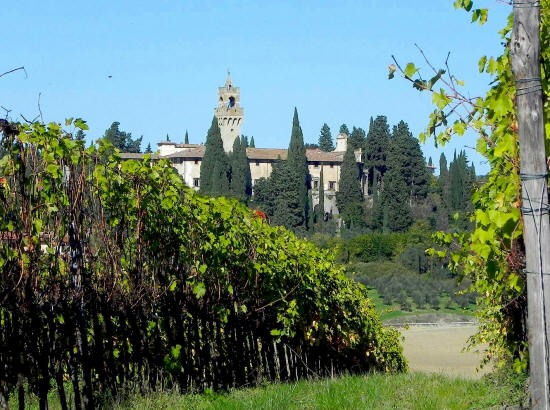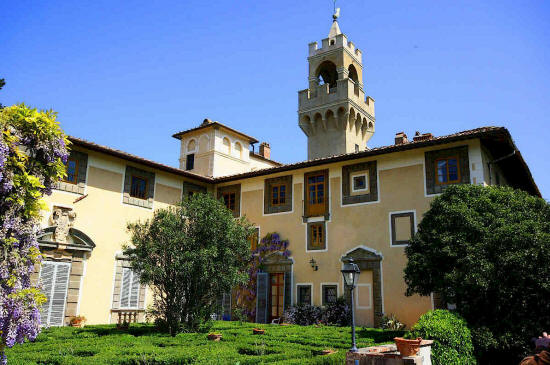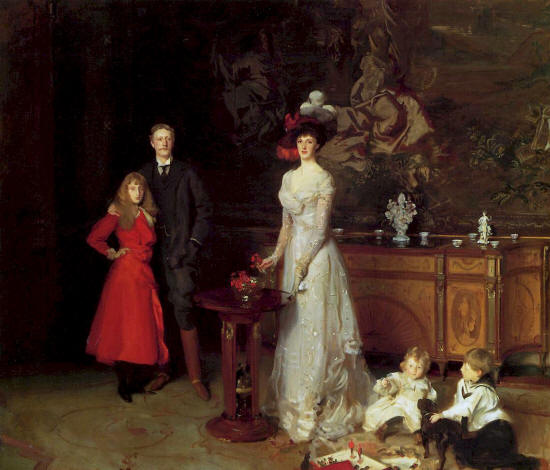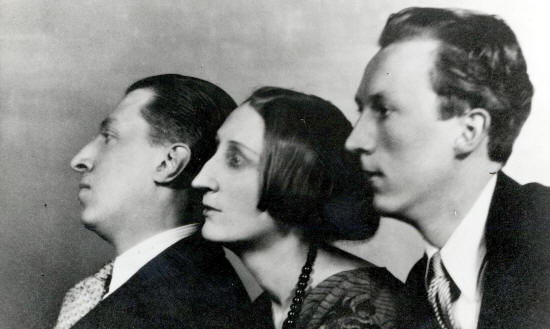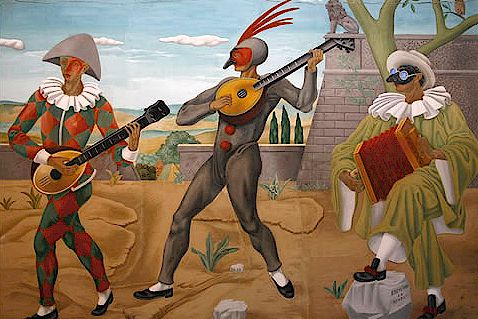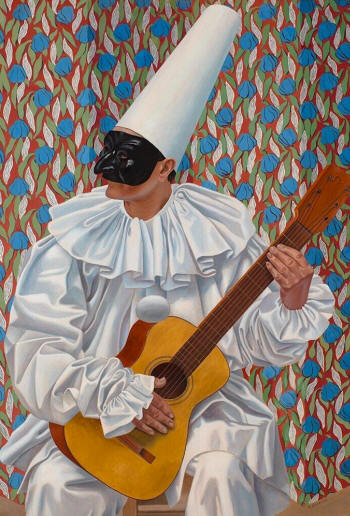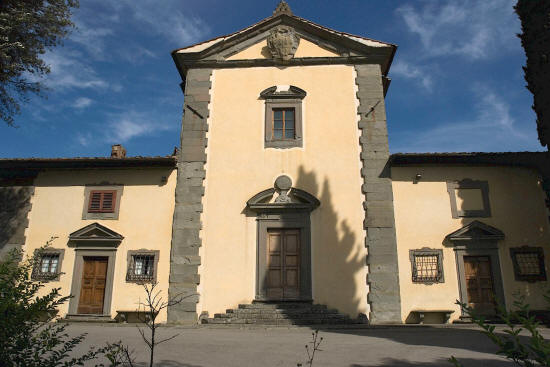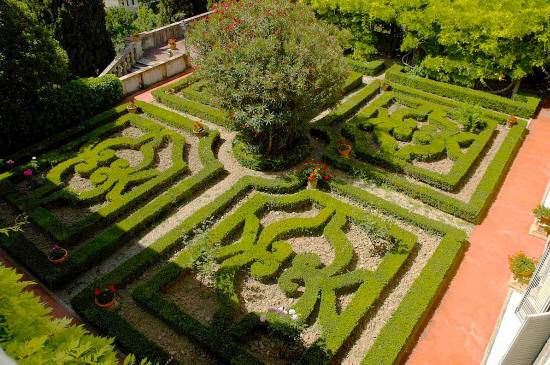|
Castle of Montegufoni |
|
Of all the castles in Tuscany, one of the most attractive is the Castello di Montegufoni which is situated near Montespertoli, 20 km south of Florence. Castello di Montegufoni This attraction is evoked both by the castle itself, as it was when owned by the Sitwells, and its literary associations, the first of which is Sir George Sitwell himself. Sir George was an English aristocratic eccentric on the grand scale who bought Montegufoni in 1909 and spent the rest of his life - he died in 1943 - restoring and decorating it. He was a garden nut whose finest book was "On the Making of Gardens", a product of his extensive knowledge of gardens, and of Italian gardens in particular. Its style is lush and over-romantic, even by Victorian standards, but that isn't especially a problem. His reflections are valuable and the book can still be read for both pleasure and profit. Castello di Montegufoni Click here for info on staying at Castello do Montegufoni. Sir George's wife, Lady Ida, was beautiful, charming (in a vapid, prattling sort of way) and monumentally extravagant. Alas, she was also a stupid woman, "slightly mentally retarded" according to Harold Acton, and she was neither able nor willing to accompany her husband on his intellectual adventures. Her main claim to fame was to fall into debt and into the hands of a blackmailer, with a consequent sentence of three months in prison for fraud in 1915 - not easily accomplished by a member of the aristocracy of that period. The Sitwell family The second literary association is with Sir George's children, Edith, Osbert and Sacheverell who dominated literary London between the wars, during the period of roughly 1916 to 1930. It was during WW I that the Sitwell siblings began to operate as a team: to be precise, at a poetry reading in the drawing room of Lady Colefax (known by her rivals - and some of her guests - as Coalbox) in December, 1917. The cultivation of a group identity turned out to be a brilliant ploy. Each Sitwell in his own way was striking, but together they made an indelible impression. For many at the time (and later), they were more entertaining and influential than the Bloomsberries and their hangers-on. Their lecture tours and performances in America after WW II were hugely successful.
Osbert, Edith and Sacheverell Sitwell All three collectively and individually ridiculed their father for his eccentricities while inexplicably sparing their mother - well, Edith disliked her mother intensely and with good reason. In fact, Sir George was clever and alarmingly energetic. Both his Derbyshire home at Renishaw and his Tuscan palace at Montegufoni were rendered immeasurably more beautiful by his activities. His only significant error was to turn down an arrangement made by Sacheverell for Picasso to paint the frescoes at Montegufoni. Sir George chose Severini instead and the work was carried out in that annus mirabilis of Modernism, 1922. The results are not too bad!
Fresco by Severini at Montegufoni Edith, the eldest of Sir George's offspring, has been the most celebrated with her many volumes of poetry and the perennial success of Fašade, an entertainment in verse with music by William Walton. However, as memories of her public readings fade, so too does her claim to fame outside the diminishing world of poetry aficionados. Osbert was a homosexual of a masculine, repressed type. In youth, as an eligible bachelor, he had had a "nasty fright" when he was briefly pursued by the predominantly lesbian Violet Keppel, later Violet Trefusis: "By Jove, I wish he'd accepted her!" her husband, Denis Trefusis, remarked when told of this incident many years later. In 1924, Mrs Keppel, Violet's mother, bought Villa L'Ombrellino, a large and beautiful villa overlooking Florence and where Galileo once lived. After her parents' death in 1947, Violet Trefusis lived in Villa L'Ombrellino until the end of her life in 1972. Osbert reigned over Montegufoni from his father's death in 1943 until his own death in 1969. Osbert's literary output has become rather neglected since his death, and been poorly rated by members of the chattering classes who haven't actually read much or any of it. I've read most of his non-poetry books with great enjoyment, especially his five volume autobiography and the collection of essays published under the very appropriate name of "Winters of Content". I recommend them. Sacheverell, the youngest of the three, single-handedly rescued baroque art and architecture from undeserved oblivion, most notably with his 1924 book, Southern Baroque Art: a Study of Painting, Architecture and Music in Italy and Spain of the 17th & 18th Centuries. He turned out over 100 books during his life. Fresco by Severini at Montegufoni The Church of San Lorenzo a MontegufoniThe Church still preserves only a few traces of its Romanesque origins and was radically transformed in the 17th century. The Acciaiolis, who were its patrons, donated outstanding works of art to the Church of San Lorenzo a Montegufoni; in fact, visitors can behold a wonderful Crucifix by the Florentine painter Taddeo Gaddi dating back to the mid 14th century and now placed on the main altar. At the beginning of the 17th century, the properties of the Acciaioli family were handed over to the Usibardi; at the end of the century Donato Acciaioli, descendant of Niccol˛, managed to buy back the properties and lands owned by his forefathers and a new period of splendor started in Montegufoni, marked by magnificence and prosperity that lasted throughout the whole 18th century. The History of Castello di MontegufoniOriginally, Montegufoni belonged to the Ormanni, a
family mentioned in Dante's Divine Comedy. In 1135, the
Florentines attacked the castle and it was left in ruins until the
13 C, when it became the property of Gugliarello Acciaioli. His
descendants enriched themselves enormously thanks to their bank and
extensive landholdings, and towards the end of the 13 C, Montegufoni
had become a complex composed of the main building and seven smaller
buildings, surrounded by walls. In 1546 another Donato restored the tower of Montegufoni in the style of the Arnolfo tower of Palazzo Vecchio in Florence and built the armoury (the hall known today as the "Gallery") and during this period Montegufoni became the meeting place of many Florentine artists. In 1612, Cosimo II de 'Medici was invited to Montegufoni. Around 1650, Donato, with his wife, Anna Maria Altoviti, restored the castle, giving it the appearance it still retains today, by connecting the seven hitherto distinct buildings together. The castle continued to be one of the most famous gathering places for high Florentine society throughout the 17 C and during the 18 C, until the economic decline of the Acciaioli family caused it to be sold to the Baracchi family. The formal garden at Castello Montegufoni
As we have seen, in 1909 Sir George Sitwell fell in love with the
beautiful castle and bought it. |
